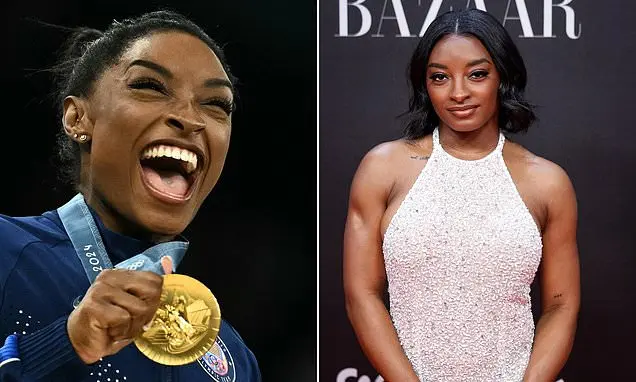In the high-stakes world of Olympic gymnastics, where every twist and vault demands perfection, Simone Biles has always stood out not just for her unparalleled athleticism but for her unfiltered honesty. The 28-year-old phenom, who clinched 11 Olympic medals and redefined what’s possible on the mat, recently pulled back the curtain on a deeply personal chapter of her life: three plastic surgeries, including a breast augmentation she says was all about embracing her own skin. As Biles navigates life beyond the arena—married to NFL star Jonathan Owens and building a brand that inspires millions—her revelations spark a broader conversation about body confidence in an era of relentless scrutiny. What drives a woman at the peak of her powers to tweak her reflection, and how does it ripple through the lives of those who look up to her?

Biles laid it all bare in a candid interview with People magazine, where she dove into the motivations behind her choices with the same precision she brings to a double layout. The breast augmentation, she clarified, wasn’t born from dissatisfaction but from a quiet desire to feel even more at home in her body. “Okay, obviously you can notice the breasts,” Biles shared, acknowledging the change that’s hard to miss. “But other than that, it’s just feeling good about yourself and loving yourself, and I’ve always been very vocal about that. And not that I didn’t like the way I looked or the way I felt. It’s just something that I notice obviously a little bit more because I live in this body, I’m just so used to it.” Her words cut through the noise of social media filters and celebrity glow-ups, reminding us that self-love isn’t always about radical reinvention—sometimes it’s about subtle affirmations that whisper, “This is enough, and then some.”
The story didn’t end with the augmentation, though. Last month, in a playful TikTok video that racked up millions of views, Biles teased her followers with a bombshell: three procedures in total, two of which are so seamless that even eagle-eyed fans might never spot them. One was a subtle nod in a social media clip—a cherry emoji hovering over a trampoline clip—that hinted at the breast work without spelling it out. The secrecy around the others adds a layer of intrigue, turning what could be a straightforward tell-all into a testament to thoughtful enhancement. After all, in a career where her body has been both her greatest asset and fiercest critic, Biles knows the line between visibility and vulnerability all too well.

Delving deeper, Biles revealed a lower blepharoplasty, a surgical fix for the “Biles eye bags” that have shadowed her family line for generations. Hereditary puffiness under her eyes and sagging skin on the lids had long been a source of frustration, especially during photoshoots where makeup artists would scramble for quick fixes. “I got a lower bleph because me and my family have, I call it the ‘Biles eye bags,’ we’ve just always had them, hereditary, and so that was just a big flaw,” she explained. “Every time I would go to a shoot, they’re like, ‘Oh, can we put some strips on her?’ And I was like, ‘Oh, baby, I had 12 hours last night, these aren’t going away. These are just hereditary,’ so it’s something that I wanted to fix.” It’s a relatable gripe for anyone who’s stared into a mirror, wondering if genetics dealt an unfair hand, and Biles’ decision to address it feels like a quiet rebellion against the idea that flaws define us.
The third surgery tugs at a childhood memory most of us can only imagine enduring: repairing her earlobe after a childhood mishap where an earring got violently ripped out. Details on the timing remain under wraps, but the incident underscores how these choices aren’t impulsive—they’re woven into the fabric of her story, mending both body and past. Together, these procedures paint a picture of a woman reclaiming agency over a form that’s propelled her to global stardom, yet occasionally felt like public property.

What elevates Biles’ disclosures beyond tabloid fodder is her insistence on transparency as a bridge to relatability. “Seeing me win medals at the Olympics, that’s not relatable,” she reflected. “But what is relatable is how we feel about ourselves, what we talk about, what we go through and how we share openly, honestly. And so that’s why I decided to share it.” In an age where Instagram reels peddle unattainable ideals, her openness serves as a counter-narrative, urging young women to prioritize inner strength over external validation. She even wove in a cautionary tale from her own experiments, recounting a Botox mishap on her 27th birthday last August. “I also think it shows young girls that they have the right to their own choices, whatever they are, and that’s no shame added as well,” Biles said. “I feel like nowadays with social media, you see everyone and you’re like, ‘Oh my God, how does she look so good?’ Social media is not real, so that’s why I try to be as transparent as possible. But that’s why also I’ve told them, on my 27th birthday I got Botox—and for me, it didn’t go well. I didn’t like it because I had a floating eyebrow and everyone was asking what that was. So I tried to share it. And it’s like, you don’t have to do these things to fall in line to seem whatever. As long as you love yourself, that’s really all that matters.”
Biles’ candor resonates especially now, as she transitions from competitive peaks to new horizons. Fresh off her Paris Olympics triumph, where she added three more golds to her tally, she’s channeling that energy into advocacy, business ventures, and family life with Owens. Her surgeries, far from a vanity project, align with a growing trend among athletes who, post-competition, seek to harmonize the physical toll of their sports with personal aesthetics. Experts in sports psychology note that such steps can foster mental resilience, allowing stars like Biles to step off the pedestal and into everyday empowerment. Yet, her story also invites curiosity: In a culture obsessed with “before and after,” does sharing these intimate tweaks humanize icons or fuel the very pressures they aim to dismantle?
Fans have flooded her comments with support, turning the conversation into a chorus of shared experiences—from moms bonding over hereditary traits to teens grappling with body image in the scroll era. Biles’ approach sidesteps judgment, framing enhancements as extensions of self-care rather than shortcuts to perfection. It’s a nuanced take that challenges the binary of “natural” versus “altered,” suggesting instead that true confidence blooms from authenticity, whatever form it takes.
As Simone Biles continues to flip the script on what it means to be a champion—on the beam or in the mirror—her revelations linger like an invitation. They prompt us to pause amid the highlight reels and ask not just how she looks, but how she feels: seen, whole, and utterly herself. In a world quick to critique, Biles reminds us that the greatest routines are the ones we perform for our own applause.






